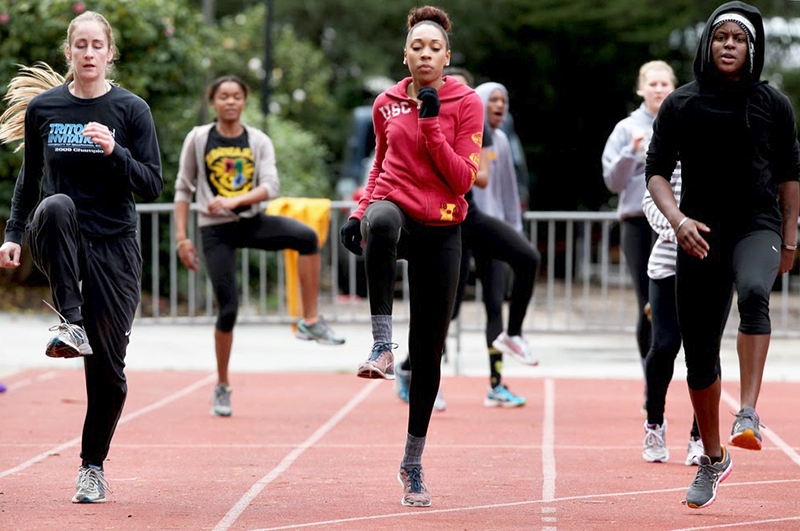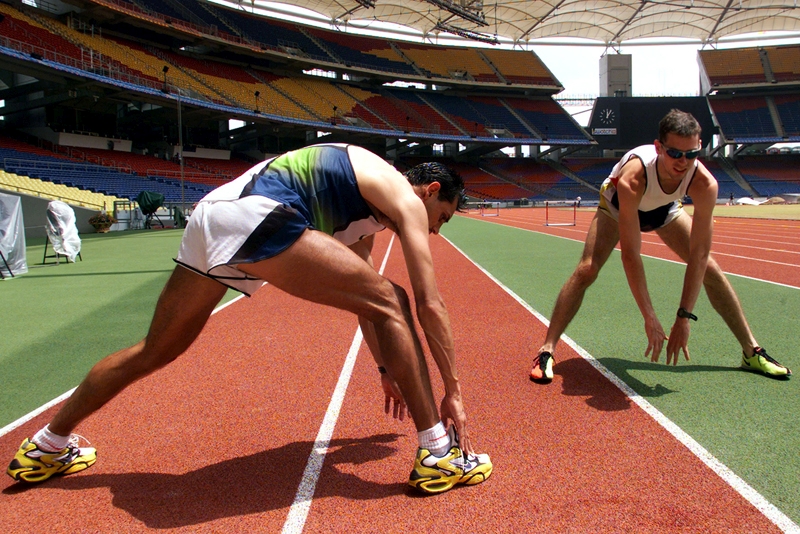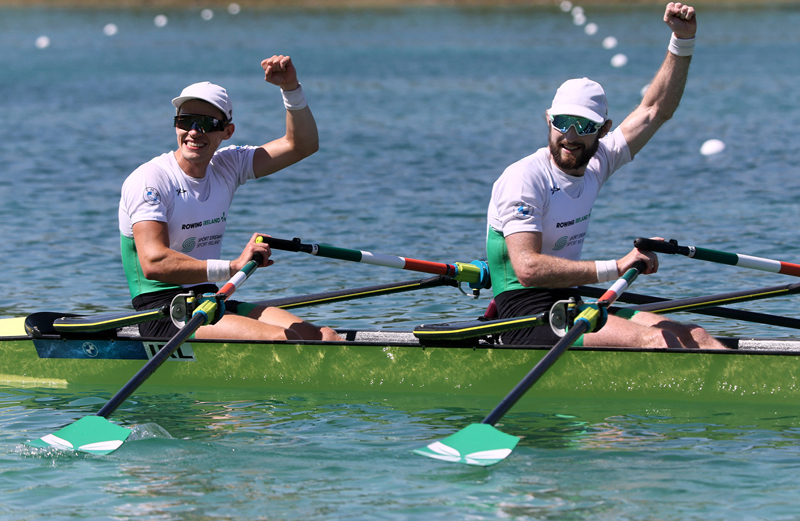You are viewing 1 of your 1 free articles. For unlimited access take a risk-free trial
The perfect half-time for better second half performance

How can team players maximize performance in the second half of matches? New research says don’t rest too much!
Team sport players where matches are in two halves face something of a dilemma; while this limited period of time provides for rest and recovery, the opportunity for refueling, and of course the all-important encouragement and discussion about tactics from the coach or team manager, it also results in a steady cool down. This cool down means that when the match is restarted, players have to start again, often in a less prepared condition than the very beginning of the match (where players will have undergone some kind of warm up prior to the match start).The cost of cooling down
The notion that players go somewhat ‘off the boil’ following a half-time break is backed by good evidence, as a deterioration in athletic performance during the second half, as compared with the first half in football matches is common. For example, compared to the first half, professional soccer players have shown a decline in the total distance covered(1) and the distance covered by high-intensity running(2) at the beginning of the second half – a time when you might actually expect better performance following the rest period.Moreover, studies have also found that when the second half performance parameters are analyzed, player’s performance during the first 15-minute segment is lower overall than during the later segments, during which, performance picks up again(3,4). This is counterintuitive; you would expect the performance in the initial segment of the second half to exceed that of the later segments, where fatigue plays an increasing role. The only rational explanation is that this performance decrement during the initial phase of the second half arises from the lack of preparation for high-intensity activities in the second half combined with poor recovery from the first half efforts.
Second half warm-ups
Studies show that the traditional static half-time rest (eg sitting on a bench) results in a reduction of the core and working muscle temperature. For example, a 10-minute passive rest after a warm-up activity can result in a 0.4°C decrease in body temperature, which can lead to a 13% reduction in maximal vertical jump height(5). The logical conclusion therefore is that passively resting during half-time is not a recommended strategy to prepare for the subsequent performance in the second half in terms of maintaining a ‘warmed-up body’.To preserve exercise-induced heat, a number of half-time activities have been explored in studies. These include: cycling(6), plyometrics and agility exercises(7), football-specific activity(8), and jogging(9). Whilst these studies have produced favorable results, the drawback is that the performance parameters tested were not actual subsequent soccer performance on the pitch, but measures of related performance such as core body temperature, sprint times and maximal jump height. IN other words, while these findings are all positives for playing performance, no actual measures of soccer performance were made.
In a recent article on half-time warm-ups, SPB looked at some research from last year, which investigated a re-warm up procedure consisting of running for one minute at 90% of the maximal oxygen uptake (hard) for the final minute of the half time break(10). To recap briefly, the study simulated a two-half match. Each simulated half comprised of repeated exercise cycles (three in total per half) designed to replicate the kind of activity typical in soccer match play. Each cycle consisted of 3 × 20m reps of walking, 1 × 20m maximal sprint, 3 × 20m reps of jogging, and 3 × 20m reps of running. The difference between the two trials was that during the half time break, the participants varied their protocols:
- In the control trial, the subjects simply rested seated for the whole 15 minutes of the half time break.
- In the ‘re-warm up’ trial, the subjects sat passively for 14 minutes, but then performed a re-warm up procedure consisting of running for one minute at 90% of the maximal oxygen uptake (hard) for the final minute of the half time break.

New soccer-specific research
While these results provide further evidence of the benefits of a half-time ‘re-warm up’ – even a very short one – some researchers remain cautious. Measuring straight-line sprinting performance doesn’t fully replicate the demands of most team sports such as soccer, basketball, rugby etc, where curved line running and agility play a major role. Given that a half-time re-warm up takes time away from team pep talks and tactical talk, coaches need to be 100% that the benefits of a re-warm up will outweigh the downsides. To try and get a definitive answer on the precise benefits of a half-time re-warm up, a brand new study by Korean sports scientists has tested the theory again, but this time using a far more soccer-specific protocol(11).In this study, researchers compared the effects of a 7-minute shuttle jog at a low-moderate intensity (70% VO2 max) during half-time to a control condition (seated rest) in 18 experienced soccer players on subsequent performance in the second half. What makes this study different however was that the simulation used was very soccer specific, consisting of 5-minute blocks of football-specific activities (jumping, sprinting, kicking, passing, and dribbling at various intensities and distances – see box 1 for more detail), repeated nine times to mimic the first and second half of a football match. Moreover, as well as sprint times and jump height, the players’ performances were also assessed using the ‘Arrowhead agility test’ – see bottom of box 1. Performances were recorded during each of 3 x 15-minutes periods in the first half and again in the second. The scores were averaged for each half to give an overall score per halft (first half: T1 to T3; second half: T4 to T6).
Box 1: Simulated soccer-specific protocol
This 29-stage, 5-minute protocol was repeated three times every 15 minutes (9 times per half). The protocol followed the numerical order as follows (1: 10-m run, 2: 10-m short pass ×2, 3: 10-m jog, 4: 40-m Arrowhead agility test (see diagram below), 5: 10-m run, 6: maximal vertical jump ×2, 7: 10-m side step, 8: 20-m walk, 9: 10-m dribble, 10: 10-m walk, 11: 30-m long kick ×2, 12: 10-m run, 13: 10-m back step, 14: 10-m side step, 15: 10-m jog, 16: 10-m short pass ×2, 17: 10-m jog, 18: 20-m sprint, 19: 10-m dribble, 20: walk, 21: 30-m long kick ×2, 22: 10-mjog, 23: 40-m Arrowhead agility test, 24: 10-m back step, 25: maximal vertical jump ×2, 26: 10-m side step, 27: jog, 28: 10-m walk, 29: 20-m sprint).Figure 1: Arrowhead agility test*

The Arrowhead agility test is a recognized way to assess soccer-specific performance. In this test, the player starts with their foot behind the starting line in a sprint start position. At the ‘go’ command, they run as fast a possible to the middle cone (A), turn to run around the side cone (C) or (D), around the far cone (B) and back through the start/finish line. The subject completes four circuits - two to the left then two to the right (as shown). *Image courtesy of Robert Wood, "Arrowhead Agility Drill Test." Topend Sports Website, 2008, www.topendsports.com/testing/tests/arrowhead-agility-drill.htm Accessed 10 August 2022.
What they found
The key findings were as follows (see figure 2):- The players’ scores for vertical jump height did not vary in the second half between the re-warm up and passive groups.
- Players performed significantly better in the sprint and Arrowhead agility tests during T4 (the first 15 minutes of the second half when they did a re-warm-up.
- In the sprint tests, the improvements were such that averaged over the entire second half, they persisted.
Figure 2: Key findings comparing 7-minute shuttle run re-warm up vs. seated rest

Changes in maximal vertical jump height (A), 20-m sprint time (B), and Arrowhead agility test time (C) over time. Squares and dotted lines = seated rest; circles and solid lines = shuttle run re-warm up. In T4 (the first 15 minutes of the second half), the re-warm up resulted in superior sprint and Arrowhead agility scores. Averaged over the whole second half, the sprint times remained faster.
Practical advice
There is now a substantial and growing body of evidence that a half-time re-warm can bring second-half sports-specific benefits to players in team sports such as soccer, rugby, basketball etc. The bulk of this benefit seems to occur during the first 15 minutes of the second half, but when it comes to sprinting capacity, may last even longer. This is important because data shows that what really marks out elite match-winning players from merely very good amateurs is the former’s excellent repeated sprint ability(12).If you’re a coach or player, how should you perform a re-warm up? It seems there’s a lot of flexibility; were obtained in the above study with seven minutes of slow to moderate jogging. Meanwhile other research shows that a shorter amount (as low as one minute) of higher intensity work can also produce benefits. What will work best will depend on the circumstances; if a lot of team talk is required , a longer seated rest at half-time followed by a shorter, more intense warm up makes sense. On the other hand, if the team talk is brief, a gentler but longer re-warm up is a good option. The key however is that any re-warm should be timed so that it ends just before the second half begins. That way, players can ensure they are fully warmed for their second half efforts, without any risk of a second cool down!
References
- J Strength Cond Res. 2016; 30: 351–359
- J Strength Cond Res. 2016; 30: 2839–2844
- Int J Appl Sports Sci. 2019; 31: 32–42
- Int J Sports Physiol Perfom. 2011; 6: 174–182
- Eur J Appl Physiol. 2012; 112: 3327–3334
- J Sports Sci Med. 2018; 17: 269–278
- PLoS One 2017; 2: e0180152
- J Sports Med Phys Fitness. 2007; 47: 263–269
- Scand J Med Sci Sports. 2015; 25: e40–e49
- Front Physiol. 2021 Jan 13;11:616158
- PLoS One. 2022; 17(7): e0270898
- J Sports Med Phys Fitness 2012; 52: 245 - 254
Newsletter Sign Up
Testimonials
Dr. Alexandra Fandetti-Robin, Back & Body Chiropractic
Elspeth Cowell MSCh DpodM SRCh HCPC reg
William Hunter, Nuffield Health
Newsletter Sign Up
Coaches Testimonials
Dr. Alexandra Fandetti-Robin, Back & Body Chiropractic
Elspeth Cowell MSCh DpodM SRCh HCPC reg
William Hunter, Nuffield Health
Keep up with latest sports science research and apply it to maximize performance
Today you have the chance to join a group of athletes, and sports coaches/trainers who all have something special in common...
They use the latest research to improve performance for themselves and their clients - both athletes and sports teams - with help from global specialists in the fields of sports science, sports medicine and sports psychology.
They do this by reading Sports Performance Bulletin, an easy-to-digest but serious-minded journal dedicated to high performance sports. SPB offers a wealth of information and insight into the latest research, in an easily-accessible and understood format, along with a wealth of practical recommendations.
*includes 3 coaching manuals
Get Inspired
All the latest techniques and approaches
Sports Performance Bulletin helps dedicated endurance athletes improve their performance. Sense-checking the latest sports science research, and sourcing evidence and case studies to support findings, Sports Performance Bulletin turns proven insights into easily digestible practical advice. Supporting athletes, coaches and professionals who wish to ensure their guidance and programmes are kept right up to date and based on credible science.













